|
|
 |
Fiche d'espèce de Copépode |
|
|
Calanoida ( Ordre ) |
|
|
|
Diaptomoidea ( Superfamille ) |
|
|
|
Fosshageniidae ( Famille ) |
|
|
|
Temoropia ( Genre ) |
|
|
| |
Temoropia mayumbaensis T. Scott, 1894 (F,M) | |
| | | | | | | Syn.: | Temeropia mayumbaensis : Marques, 1953 (p.109, fig.F); 1959 (p.214); Björnberg, 1963 (p.48, Rem.); Pavlova, 1966 (p.44); Dias & Araujo, 2006 (p.66, Rem., chart); Ayon & al., 2008 (p.238, Table 4: Peruvian samples); Dias & al., 2010 (p.230, Table 1);
no Temoropia mayumbaensis : Farran, 1908 b (p.59, figs.F, Rem.); Holmes, 2001 (p.29);
No Temoropia mayumbaensis: Wheeler, 1970 (p.12, "slender P5", figs.F) | | | | Ref.: | | | T. Scott, 1894 b (p.79, figs.F,M); Giesbrecht & Schmeil, 1898 (p.96); Thompson & Scott, 1903 (p.234, 248); A. Scott, 1909 (p.119, Rem.); ? Farran, 1929 (p.209, 257, figs.F); Sewell, 1932 (p.246, Rem.); Rose, 1933 a (p.174, figs.F,M); Farran, 1936 a (p.110, figs.F,M, Rem.); C.B. Wilson, 1942 a (p.209, figs.F,M); Grice, 1962 (p.213, figs.F,M); Chen & Zhang, 1965 (p.67, figs.F); Vervoort, 1965 (p.102, Rem.); Owre & Foyo, 1967 (p.69, figs.F,M)); Vilela, 1968 (p.23, fig.F); Corral Estrada, 1970 (p.172); Wheeler, 1970 (part, p.12, "thickened P5", figs.F); Björnberg & al., 1981 (p.640, figs.F,M); Schulz, 1986 (p.141, Rem.); Kim & al., 1993 (p.270); Chihara & Murano, 1997 (p.916, Pl.180: F,M); Bradford-Grieve & al., 1999 (p.884, 954, figs.F,M); Boxshall & Halsey, 2004 (p.122); Vives & Shmeleva, 2007 (p.528, figs.F,M, Rem.); Blanco-Bercial & al., 2011 (p.103, Table 1, Biol. mol, phylogeny) |  issued from: Q.-c Chen & S.-z. Zhang in Studia Marina Sinica, 1965, 7. [Pl.21, 10-12]. Female (from E China Sea): 10, habitus (dorsal); 11, urosome (lateral right side); 12, P5 (posterior).
|
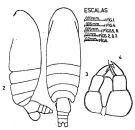 issued from : J. Corral Estrada in Tesis Doct., Univ. Madrid, A-129, Sec. Biologicas, 1970. [Lam.47, figs.2-4]. Female (from Canarias Is.): 2, habitus (lateral left side); 3, idem (dorsal); 4, P5.
|
 issued from : C.B. Wilson in Scientific Results of Cruise VII of the Carnegie during 1928-1929. Biology-I. Carnegie Inst. Wash. Publ. 536, 1942. [p.231, Figs.116-117]. Female (from Pacific): 117, P5. Male (from Pacific): 116, P5.
|
 Issued from : E.H. Wheeler, Jr in Smiths. Contr. Zool., 1970, 55. [p.27, Figs.67-70]. As Temoropia mayumbeensis with \\\"thicknened \\\" P5. Female (from NW Atlantic): 67, habitus (lateral); 68, P5; 69, rostrum (ventrolateral view); 70, urosome (three-quarter ventral view).
|
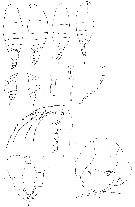 issued from : G.D. Grice in Fish. Bull. Fish and Wildl. Ser., 1962, 61. [p.214, Pl.20, Figs.1-12]. Female (from equatorial Pacific): 1, habitus (dorsal and lateral, respectively); 3-4, posterior part of thorax and urosome (left and right sides, rspectively); 5, Mxp; 6, P5. Male: 7-8, habitus (dorsal and lateral, respectively)9, rostrum; 10, A1; 11, distal two segments of A1; 12, P5.
|
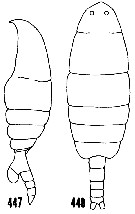 issued from : H.B. Owre & M. Foyo in Fauna Caribaea, 1, Crustacea, 1: Copepoda. Copepods of the Florida Current. [p.69, Figs.447, 448]. Female: 447, habitus (lateral). Male:448, habitus (dorsal).
|
 issued from : H.B. Owre & M. Foyo in Fauna Caribaea, 1, Crustacea, 1: Copepoda. Copepods of the Florida Current. [p.21, Figs.80, 81]. Female: 80, P5. Male: 81, P5.
|
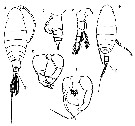 Issued from : M. Chihara & M. Murano in An Illustrated Guide to Marine Plankton in Japan, 1997. [p.918, Pl. 180, fig.280 a-f]. Female : a, habitus (dorsal); b, P5; c, urosome (lateral); d, P1. Male: e, habitus (dorsal); f, P5. Note characteristics numbered 1 into circles.
|
 Issued from : V.N. Andronov in Russian Acad. Sci. P.P. Shirshov Inst. Oceanol. Atlantic Branch, Kaliningrad, 2014. [p.84, Fig.21: 5]. Temoropia amyumbaensis after Deevey, 1972. Female P5.
| | | | | Ref. compl.: | | | Sewell, 1948 (p.418, 428, 440, 502, 546); Heinrich, 1961 (p.87); Grice & Hart, 1962 (p.287, 293: Rem.); V.N. Greze, 1963 a (tabl.2); Grice, 1963 a (p.495); Shmeleva, 1964 a (p.1068); Unterüberbacher, 1964 (p.26); De Decker & Mombeck, 1964 (p.14); Grice & Hulsemann, 1965 (p.224); 1967 (p.17); Furuhashi, 1966 a (p.295, vertical distribution in Oyashio/Kuroshio transitional area, Table 8); Fleminger, 1967 a (tabl.1); Vinogradov, 1968 (1970) (p.79); Delalo, 1968 (p.138); Park, 1970 (p.476); Deevey, 1971 (p.225); Gamulin, 1971 (p.382, tab.3); Bainbridge, 1972 (p.61, Appendix Table I: vertical distribution vs day/night, Table II: %); Binet & al., 1972 (p.69); Heinrich, 1973 (p.95); Corral Estrada & Pereiro Muñoz, 1974 (tab.I); Deevey & Brooks, 1977 (p.256, tab.2, Station "S"); Carter, 1977 (1978) (p.36); Dessier, 1979 (p.201, 206); Kovalev & Shmeleva, 1982 (p.84); Vives, 1982 (p.293); Greze & al., 1983 (p.17); Scotto di Carlo & al., 1984 (p.1043); Greze & al., 1985 (p.7); Almeida Prado Por, 1985 (p.250); Brenning, 1985 (p.5, Rem.: p.13); 1985 a (p.28, Table 2); Brinton & al., 1986 (p.228, Table 1); Madhupratap & Haridas, 1986 (p.105, tab.1); Lozano Soldevilla & al., 1988 (p.59); Scotto di Carlo & al., 1991 (p.270); Shih & Young, 1995 (p.74); Padmavati & Goswami, 1996 a (p.85, fig.3, Table 4, vertical distribution); Hure & Krsinic, 1998 (p.60, 101, 112); Padmavati & al., 1998 (p.349); Suarez-Morales & Gasca, 1998 a (p.111); Madhupratap & al., 2001 (p. 1345, vertical distribution vs. O2, figs.4, 5: clusters, p.1353); Vukanic, 2003 (139, tab.1); Hsiao & al., 2004 (p.326, tab.1); Lo & al., 2004 (p.89, tab.1); Vukanic & Vukanic, 2004 (p.9, tab. 2); Kazmi, 2004 (p.229); Valdés & al., 2007 (p.104: tab.1); Dur & al., 2007 (p.197, Table IV); Cornils & al., 2007 (p.278, Table 2); Morales-Ramirez & Suarez-Morales, 2008 (p.522); Lan Y.-C. & al., 2008 (p.61, Table 1, % vs stations, Table 2: indicator species); C.-Y. Lee & al., 2009 (p.151, Tab.2); Licandro & Icardi, 2009 (p.17, Table 4); Cornils & al., 2010 (p.2076, Table 3 as Temeropia mayumbiensis); Schnack-Schiel & al., 2010 (p.2064, Table 2: E Atlantic subtropical/tropical); Mazzocchi & Di Capua, 2010 (p.428); Medellin-Mora & Navas S., 2010 (p.265, Tab. 2); Andersen N.G. & al., 2011 (p.71, Fig.3: abundance); Hsiao S.H. & al., 2011 (p.475, Appendix I: as Tomoropia, lapsus calami); in CalCOFI regional list (MDO, Nov. 2013; M. Ohman, comm. pers.); Tachibana & al., 2013 (p.545, Table 1, seasonal change 2006-2008); Lidvanov & al., 2013 (p.290, Table 2, % composition); Siokou & al., 2013 (p.1313, fig.4, 8, biomass, vertical distribution); Bonecker & a., 2014 (p.445, Table II: frequency, horizontal & vertical distributions); Belmonte, 2018 (p.273, Table I: Italian zones); Hure M. & al., 2018 (p.1, Table 1: abundance, % composition, Table 2: correlations, Rem.: p.12) | | | | NZ: | 15 | | |
|
Carte de distribution de Temoropia mayumbaensis par zones géographiques
|
| | | | | | | | | | | | 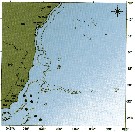 issued from : C. de O. Dias & A.V. Araujo in Atlas Zoopl. reg. central da Zona Econ. exclus. brasileira, S.L. Costa Bonecker (Edit), 2006, Série Livros 21. [p.31]. As Temeropia mayumnbaensis. issued from : C. de O. Dias & A.V. Araujo in Atlas Zoopl. reg. central da Zona Econ. exclus. brasileira, S.L. Costa Bonecker (Edit), 2006, Série Livros 21. [p.31]. As Temeropia mayumnbaensis.
Chart of occurrence in Brazilian waters (sampling between 22°-23° S).
Nota: sampling 14 specimens. |
| | | | Loc: | | | South Africa (E), Namibia, Angola, Congo, G. of Guinea, Brazil (off Rio de Janeiro, Vitoria-Cabo de Sao Tomé, off Macaé), Ivorian shelf, off Amazon, off Morocco-Mauritania, Canary Is., Portugal, NW Spain, Ibero-moroccan Bay, Barbados Is., Caribbean Sea, Caribbean Colombia, G. of Mexico, Florida, Sargasso Sea, off Bermuda: Station ‘’ S’’ (32°10’N, 64°30’W), Medit. (Alboran Sea, W Basin, Ligurian Sea, Tyrrhenian Sea, S Adriatic Sea, Ionian Sea, Aegean Sea, Johnston Bank, Lebanon Basin), G. of Suez, G. of Aqaba, Red Sea, Arabian Sea, W India (Goa - Gujarat), Natal, Indian, Indonesia-Malaysia, SW Celebes, China Seas (East China Sea), Taiwan (SW, E, N: Mienhua Canyon, NW), S Korea, Japan (Tokyo Bay, S Bösö); off SE Japan, Australia (Great Barrier), New Zealand, Pacif. (W equatorial), California, Gulf of California, W Costa Rica, Peru | | | | N: | 102 | | | | Lg.: | | | (5) F: 0,94; M: 0,9; (16) F: 1,045-0,99; (34) F: 0,92-0,7; M: 0,84; (35) F: 0,78; (57) F: 0,93; M: 0,93; (54) F: 1,17-1; M: 0,99-0,96; (75) F: 1,11-0,93; M: 0,98-0,86; (101) F: 0,99-0,94; M: 0,92-0,88; (180) F: 0,87; (203) F: 0,56; 0,75; 0,79; 0,86; (237) F: 1,0; M: 0,9; (327) F: 0,86; (432) F: 1,15; (1308) F: 1,06; M: 0,9-1,06; {F: 0,56-1,17; M: 0,84-1,06} | | | | Rem.: | méso-bathypélagique.
Un doute subsiste sur l'identification de T. mayumbaensis de Farran (1929) qui pourrait être Temoropia minor.
Voir aussi les remarques en anglais | | | Dernière mise à jour : 27/10/2020 | |
|
|
 Toute utilisation de ce site pour une publication sera mentionnée avec la référence suivante : Toute utilisation de ce site pour une publication sera mentionnée avec la référence suivante :
Razouls C., Desreumaux N., Kouwenberg J. et de Bovée F., 2005-2025. - Biodiversité des Copépodes planctoniques marins (morphologie, répartition géographique et données biologiques). Sorbonne Université, CNRS. Disponible sur http://copepodes.obs-banyuls.fr [Accédé le 30 novembre 2025] © copyright 2005-2025 Sorbonne Université, CNRS
|
|
 |
 |













